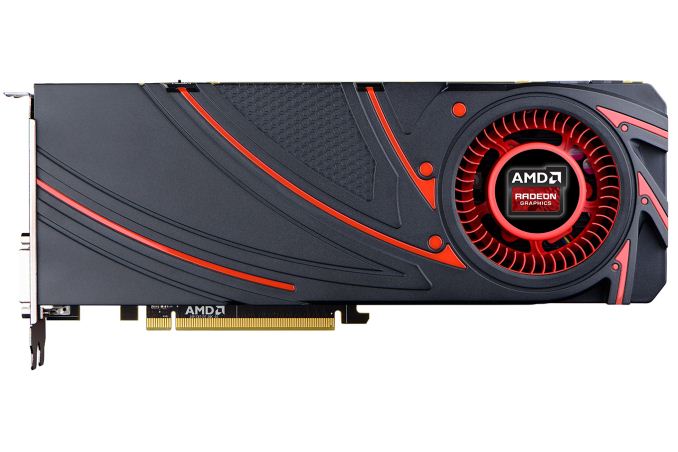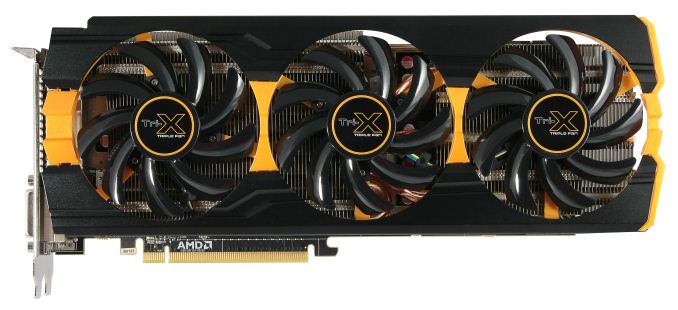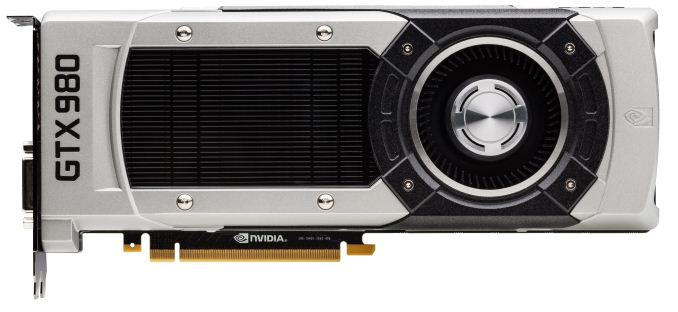AMD Radeon R9 290 Series Prices Finally Begin To Fall
by Ryan Smith on October 7, 2014 12:00 PM EST
With the launch of NVIDIA’s Maxwell-powered GeForce GTX 900 series last month, it was immediately obvious that NVIDIA had been able to deal a swift blow to AMD’s product lineup by surpassing AMD’s performance while significantly undercutting their pricing. At the time we were expecting AMD to quickly respond with the necessary price cuts to keep the R9 290 series competitive with the GTX 900 series, but surprisingly even a week later this had yet to happen.
Now a bit over two and a half weeks after the GTX 900 series launch, we’re finally seeing Radeon R9 290 series pricing fall in response to NVIDIA’s launch. AMD has not announced an official price cut at this time – and admittedly neither AMD nor NVIDIA tend to announce reactive price cuts – so it’s not clear whether this is AMD’s doing, board partner’s, retailers, or most likely all three. But regardless, retail video card prices at Newegg and other etailers have seen some substantial drops that help bring back at least some balance between AMD and NVIDIA’s high end video card lineups.
A number of Radeon R9 290 cards can now be found for around $300 after rebate, with a couple more factory overclocked models at $310. With HIS, Sapphire, PowerColor, Asus, and XFX represented, this is a broad selection of vendors with a bit less than half of Newegg’s stock now at or around $300. Meanwhile R9 290X can be found for $399, again with a wide selection of vendors and roughly half of Newegg’s stock at or near that price. The remainder of Newegg’s stock in turn generally consists of heavily overclocked or otherwise premium cards that carried their own price premium before these latest cuts.
Speaking of AMD card prices, it should also be noted that AMD’s Never Settle Forever bundle is still active even after this round of price cuts. AMD and their partners will be continuing to try to influence the value proposition of their products by including free games.
For AMD these price cuts don’t come a moment too soon, and while they are going to help the competitive landscape I’m not convinced this is the last time we’re going to see AMD cut prices. As we discussed in our review of the GTX 970, comparing stock-to-stock, the $329 GTX 970 is every bit as fast as the now $400 R9 290X. If AMD wants to be price/performance competitive with NVIDIA then there’s still an additional $70 price difference between the two cards, a gap further muddied by AMD’s game bundle and NVIDIA’s superior energy efficiency. Strictly speaking $400 may not be low enough for the R9 290X, but no doubt AMD wants to see what sales are like at $400 before cutting prices on their single-GPU flagship any further.
The R9 290 on the other hand is in an interesting spot. At resolutions below 2160p it trails the GTX 970 by around 10%, but then again at $300 it’s also priced about 10% lower. Since it ships at a lower clockspeed than R9 290X a lot of AMD’s partners also goose the core clock on R9 290, which improves performance a bit but isn’t enough to close that 10% gap. What it does mean however is that at least so long as energy efficiency is not a concern, R9 290 is appropriately priced for its performance. However if energy efficiency is a concern, then AMD doesn’t have any kind of counter to GM204 at this time.
If anything the one wildcard at this point is the availability of the new GeForce cards. Despite stock more-or-less holding up immediately post launch, we’ve seen both the GTX 980 and GTX 970 go out of stock in the last week. As of the time of this writing it looks like Newegg has received their Tuesday shipment, so there is stock available, but it’s a thin selection of just a few different cards (including a model or two at MSRP). For prospective buyers this means either playing inventory games or grabbing the AMD alternative, and for AMD this is all the more reason not to cut prices too drastically while GeForce availability is still limited. As for NVIDIA it’s been a while since we’ve seen them capacity constrained on the high end, so while it’s solid evidence that they’ve done everything right with the GTX 900 series launch, it does mean that they’re also going to be leaving sales on the table until supply and demand level out.
| Fall 2014 GPU Pricing Comparison | |||||
| AMD | Price | NVIDIA | |||
| Radeon R9 295X2 | $1000 | ||||
| $550 | GeForce GTX 980 | ||||
| Radeon R9 290X | $400 | ||||
| $330 | GeForce GTX 970 | ||||
| Radeon R9 290 | $300 | ||||
| Radeon R9 280X Radeon R9 285 |
$250 | ||||
| Radeon R9 280 | $200 | GeForce GTX 760 | |||
Source: The Tech Report












69 Comments
View All Comments
MrSpadge - Tuesday, October 7, 2014 - link
I'd like to see AMD at least use their current chips properly by tweaking their clock-voltage profiles. R9 285 uses about 1.15 V even at 918 MHz. That's insanely bad for a GPU using the mature 28 nm process. No wonder their energy efficiency is so bad in comparison.And Hawaii: AMD also uses high voltages for the top speed bins, which is fine for a high end product with a massive TDP, but they hardly scale that voltage down when they have to lower the GPU frequency due to hitting power and thermal limits. No wonder performance suffers so much once Hawaii hits these limits.
Wreckage - Tuesday, October 7, 2014 - link
They had to water cool their dual chip card. AMD pushed their GPUs to their absolute limit in order to compete with the 7xx series. Now the 9xx series is simply on another level. They will need to drop their price a lot more to even be considered "competitive" at least in price/performance. I believe the technological gap between them is just too much for AMD to overcome.TiGr1982 - Tuesday, October 7, 2014 - link
Not completely "on another level", and not so huge technological gap, but, yes, AMD is lagging now (counting from GTX 9xx release); they better should do something about that, indeed.chizow - Tuesday, October 7, 2014 - link
No, given the fact it is still on 28nm, Maxwell really is on another level. It not only outperforms previous generation handily, it uses less power in doing so, all on the same process node. On another level.TiGr1982 - Tuesday, October 7, 2014 - link
You guys are overexcited by Maxwell. Let's quantify things a bit. I would say "on completely another level" if it's really 2X performance/watt, as was advertised. But it seems to be not the case. On desktop (the subject of the pipeline) GTX 780 Ti uses around 250 W and yes, it is surpassed by 10% on average by GTX 980, which uses around 180 W (and not really 165 W, as advertised, see AT own power consumption charts in GTX 980 review).So, the practical performance per watt ratio of GTX 980 vs 780 Ti is like 250/180 * 1.1 ~= 1.53.
Say, 1.5X. Same for mobile GPU parts, I assume - in around 100 W there for top MXMs you get around 40-50% more performance from 980M, than from 880M, with the same number of CUDA cores, which actually does correspond to the promised average 40% increase in CUDA core efficiency from Kepler to Maxwell.
Yes. it is exceptionally good by itself, considering the fact, that it's the same 28 nm, so all gains are because of the totally re-hauled GPU architecture (Maxwell vs Kepler meant).
However, it's not 2X, as was advertised and it's not 2X as was in the past with the jump to the next mfg node. So, to me, it's not a "totally different level". But yes, its much better than Kepler and current AMD's products, and yes, it's a problem for AMD now.
dragonsqrrl - Tuesday, October 7, 2014 - link
It's not quite 2X performance per W, but it's close enough that people aren't compelled to challenge the marketing claim. That in itself should be beyond impressive to any informed enthusiast, so your reaction seems a little strange to me. I don't think the comments you're responding to are 'overexcited' about Maxwell, at least no more so than the countless articles by tech journalists praising GM204 since launch. And I'm sure it varies a bit per benchmarking suit, but according to Anandtech the 980 is ~13% faster then the 780Ti, not taking into account superior overclocking headroom.TiGr1982 - Tuesday, October 7, 2014 - link
Well, I'm from natural sciences, so I just like to quantify things a bit. OK, if it's 13% advantage of 980 vs 780 Ti, then the perf/watt leap of Maxwell vs Kepler is 1.57 - closer to 1.6X (60%).When I was saying "overexcited", I just meant the perf/watt ratio is not 2X - it's actually smaller.
Generally, regardless of the particular GPU vendor from RGB triad (Red = AMD, Green = nVidia, Blue = Intel with its integrated Iris GPUs), it would be nice to see HBM (GDDR5 is so long in the tooth, more than 6 years on the market already), new mfg nodes and DX12 in real action. That's what I would call really interesting IMHO.
dragonsqrrl - Tuesday, October 7, 2014 - link
I'm guessing Nvidia decided to delay HBM a gen for a reason. I'm not super familiar with it, but I'm a little curious about the practical real world benefits HBM would bring to upcoming gen cards unless it's actually paired with a GPU that can take advantage of the additional bandwidth, so at least for now it may very well benefit AMD's architecture more than Nvidia's. Has it been confirmed that AMD with be integrating HBM into their lineup next year?Given the the current state of memory bandwidth constraints both companies are having to get creative, and it seems like Nvidia has already found a practical solution moving forward for Maxwell (larger cache and more efficient image compression). But I'm guessing this won't last very long, to scale performance further, beyond a big die Maxwell on a 384-bit bus, Nvidia will need something new.
... actually, what ever happened to GDDR6?
TiGr1982 - Tuesday, October 7, 2014 - link
1) HBM or similar new memory tech for GPUs will happen eventually, but now AFAIK it's all in the rumours. Nothing is confirmed as of yet.2) GDDR5 is a derivative from DDR3, so, then, "GDDR6" would be a derivative from DDR4.
Currently, DDR4 does not have that much bandwidth advantage with respect to DDR3, so, I'm just assuming, "GDDR6" may not happen - instead, HBM may be used in the future, skipping "GDDDR6" altogether.
3) Indeed, probably, common sense points that big die Maxwell will be on 384 bit bus, but later on, next GPU generation ("Pascal") may use some different and more advanced memory solution like HBM or similar.
chizow - Tuesday, October 7, 2014 - link
@dragonsqrrl, HBM or stacked DRAM was always on their roadmap for the arch after Maxwell. That recently changed from Volta to Pascal, but it was never planned for Maxwell. Unified virtual memory was however, but that got bumped down to Pascal. Nvidia did do some tweaks to bandwidth for Maxwell in the form of new compression algorithms and it seems to hold up well on 256-bit Maxwell parts at 4K.http://www.anandtech.com/show/7900/nvidia-updates-...